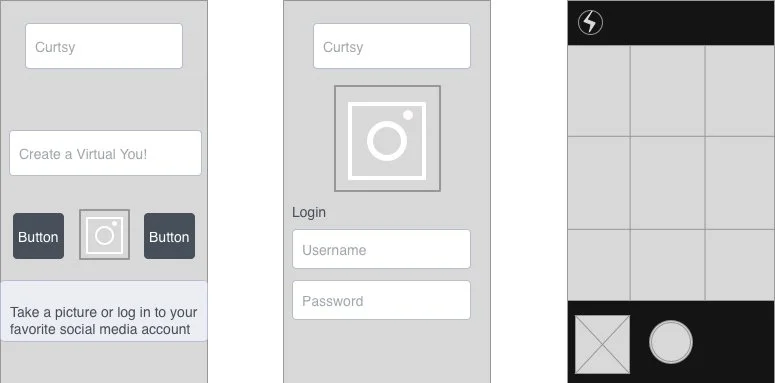
Curtsy Virtual Try-On
A new way to try on clothes
Overview
Curtsy is a clothing reselling platform tailored to female teens to young adults. It allows women to list their clothes, shoes, and accessories, used or unused, for resale as a more sustainable alternative when shopping for clothes.
This study will focus on understanding users’ journey with the website/app to purchase and sell clothing and how to improve it. The proposed feature is a virtual rendering of the user made using exact measurements that would allow them to try on clothing digitally.
Role
Product Designer
User Research, Interaction, Visual design, Prototyping & Testing
July 2021 - August 2021

Challenges
With many clothing lines focusing on a general body type or having different sizing from one another, women struggle to easily find something that will flatter their bodies and fit without compromising on something. This feature should aid in eliminating the uncertainty of sizing and fitting and reduce overall time spent viewing individual clothing items. While the minimum age requirement is 16, it is not uncommon for users 15 and younger to create accounts on Curtsy. It is also not uncommon for users of the app to be individuals whose first language is not English, as the app's purpose is to sell or purchase second-hand clothing for a lower price. The feature's design must take this into consideration while remaining easy to understand with minimal instructions.
Research Goals
Learning Objectives: Understand how and why users purchase or sell on thrifting apps, uncover any difficulties they face, and determine how to improve their experience
Proposed Feature: The feature I propose would be a way to allow users to virtually try on the article of clothing before they purchase to see if they like how it looks on them, thus reducing the number of returns and improving customer satisfaction.
Research Questions: Ask questions to understand the users' experience with the app, identify any pain points or problems, and ask for opinions on the proposed feature.
Key Assets/Resources: Competitive Analysis, Interview Guide, interviews-3 Buyers, 3 Sellers
Timing: Interview screening over a week, interviews split into two days, one for each user type
Personas
Leen, 18 (Seller)
Rachel, 24 (Buyer)
Rachel is a recent graduate working as a consultant. She loves fashion. However, with her busy schedule, Rachel does not have time to spend hours at the mall to find new clothes and prefers online shopping. Also, with the fashion industry constantly changing and pushing out new trends, she finds herself looking for cheaper clothes on reseller apps that she can get wear out of and throw out or donate when done with to make room for new clothes. Finally, she likes straightforward, easy-to-use shopping apps that will not take too much time.
Leen is an incoming freshman at her local university. She likes to spend her time watching TikToks and looking at Instagram to see what is the latest fashion trend. However, since she has no job during the school year, Leen sells her old clothes online in order to fund her newest TikTok and Instagram-inspired outfit. She is tech-savvy but prefers more standard-type apps that are not difficult to post clothes on or look at clothes.
Goals:
To be able to keep up with constantly changing fashion trends
To find cute, affordable clothes that she can wear without spending too much money
To find clothes that will complement and highlight her figure
Frustrations:
spending long hours browsing through shopping apps
not knowing if clothes will fit her body type based on online photo
having to deal with returns/not being able to return items that do not fit
Goals:
To be able to sell unused clothes and make extra money
To be able to get a decent offer on clothes
To get good reviews on purchases to boost scores, leading to more potential customers
Frustrations:
Thinking about the best descriptions for clothing pieces
Dealing with unsatisfied customers and bad reviews that hurt her profile rating
Dealing with customers asking for a lower price, thus losing profit since the Curtsy App takes a portion
Key Findings
Buyers:
Buyers are too busy to go to the mall to shop, do not want to spend too much money, click through apps multiple times throughout the day, and struggle to determine if the item will fit their body type based on photos and description alone
Sellers:
Want an easy way to make a quick buck, good reviews are essential for business, must be conscious of photo angles to correctly display products and watch what is written for product descriptions, and unhappy customers are inevitable
Both:
A constant issue for both involves unhappy purchases and not being able to return (all items are final sale)
Understanding the Problem
After conducting several interviews, it was found that the app was straightforward to understand. While there were a couple of questions along the way, everyone made it to the "Check Out" screen without guidance. The main issues found consisted of:
Clothing items need to have multiple reviews detailing the fit
Clothing needs to be modeled by several people of different body types
Product descriptions need to be more descriptive

How might we reduce the time shoppers spend determining whether a piece of clothing will fit them.
This project introduces a feature that allows users to create a virtual version of themselves with which they can select available clothing to try on before purchasing. The feature transforms the body's shape to fit the measurements specified by the users and filters in clothing options that will fit the virtual user based on those measurements.
Manual Scope
Once the initial research and interviews concluded, I found there was a need for my proposed feature and began the design process.
Wireframes

Design Updates
Based on the feedback on the feature, I added a quick view of the clothing details and more clothing option filters to give each shopper the maximum amount of information needed to be satisfied with their shopping decisions.
Prototype
Once the wireframes were finalized, I created a clickable prototype used for user testing interviews.
Results and Takeaways
A positive reaction was received from both user types. All participants believed that the proposed feature would aid greatly in making the purchasing of clothes a lot easier, thus cutting back on unhappy final sale purchases. Sellers also believed the added feature will help with reducing the amount of negative feedback on their profiles about how the products don’t exactly match the description, thus improving/maintaining their seller scores.
Based on my findings, I believe that all my assumptions were validated, and my proposed feature will help to eliminate a lot of the “bad” experiences found for each category.









